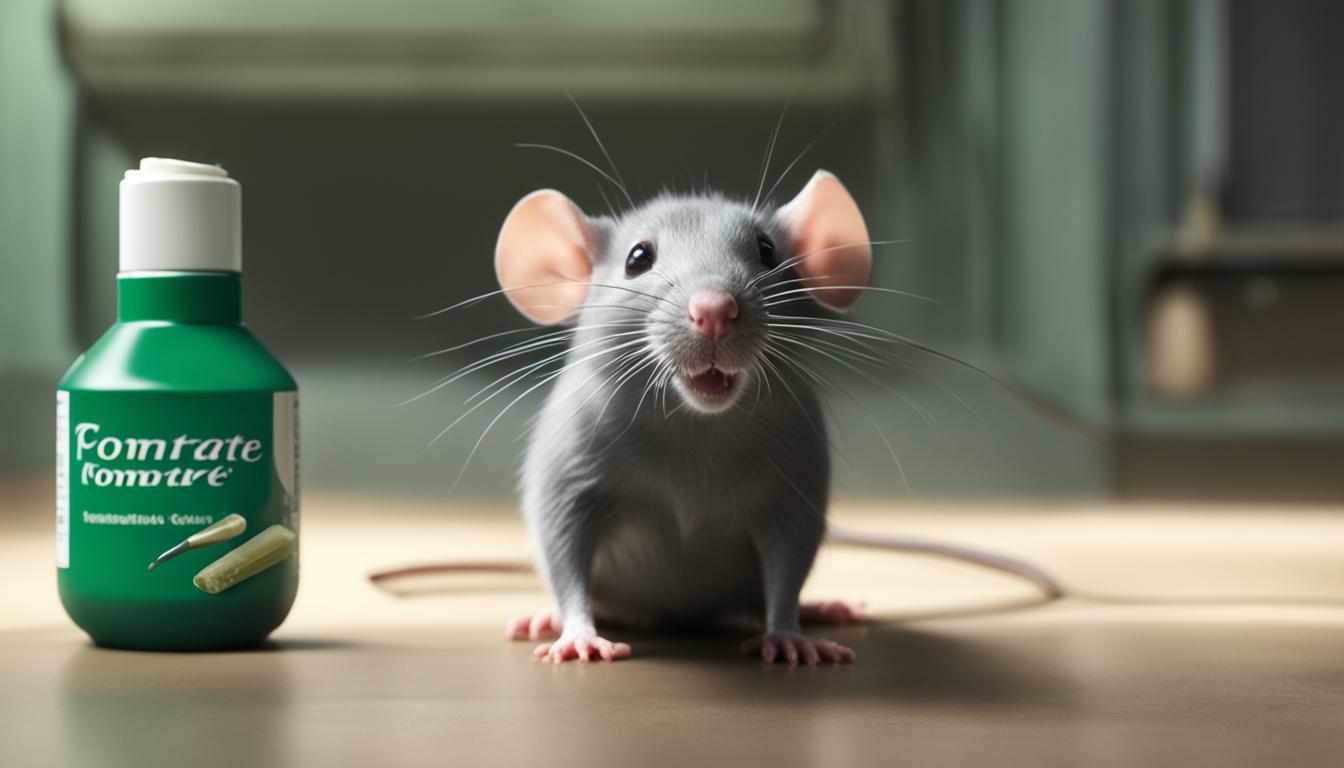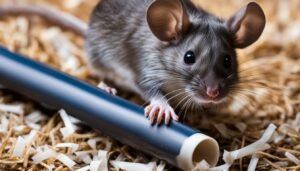Many homeowners wonder if toothpaste can be used as a means to kill rats and control rodent infestations. While toothpaste does contain sodium fluoride, which is toxic to rodents, it is unlikely that rats would consume enough toothpaste to be lethal. Additionally, toothpaste may not be attractive enough to rats compared to other available food sources. However, toothpaste can potentially be mixed with other substances to enhance its effectiveness as a mouse repellent. In this article, we will explore the potency of toothpaste as a rat killer, its appeal to rats, and alternative rat control methods.
Key Takeaways:
- Toothpaste can potentially kill rats if they consume a large enough quantity, but it is unlikely that they would eat enough toothpaste to be lethal.
- The main ingredient in toothpaste, sodium fluoride, is toxic to rodents, but a fatal dose for rats is much larger than what is typically found in toothpaste.
- Rats are unlikely to be attracted to toothpaste due to the availability of more enticing food sources.
- Toothpaste may need to be mixed with other substances to make it more attractive to mice if it is being used as a mouse repellent.
- There are other household items, such as baking soda, peppermint oil, and bay leaves, that can be used for rat control.
The Potency of Toothpaste as a Rat Killer
Toothpaste contains sodium fluoride, which is toxic to rodents and has the potential to kill rats if they consume a large enough quantity. A fatal dose for rats is around 52 mg of sodium fluoride, which means that a pea-sized amount of toothpaste containing 0.972 mg of sodium fluoride could potentially be lethal to a rat. However, it is important to note that rats are unlikely to be attracted to toothpaste as their primary food source. There are usually more enticing options available to them.
If toothpaste is being used as a mouse repellent, it would need to be mixed with other substances to make it more attractive to mice. There is no specific information available on the effectiveness of toothpaste in killing rats, but it is possible that it may have similar effects on mouse populations. However, it is always recommended to explore other rodent control methods beyond toothpaste.
When it comes to rat control, there are several household items that can be used as alternatives to toothpaste. Baking soda, for example, is known for its ability to deter rats. Its strong odor and taste can repel rodents. Peppermint oil is another natural rat repellent that can be effective in keeping rats away from certain areas. Bay leaves are also believed to have rat-repellent properties. Placing them strategically in areas where rats are likely to enter can help deter them.
| Household Items for Rat Control |
|---|
| Baking soda |
| Peppermint oil |
| Bay leaves |
However, it is important to remember that rat control is a complex issue and requires a holistic approach. Preventative measures such as sealing entry points and reducing attractants in and around the home play a crucial role in reducing rat populations. Exploring various rodent control strategies, such as traps, baits, and professional extermination services, may also be necessary depending on the severity of the infestation. Homemade rat poison can be dangerous and should be approached with caution.
Unlikely Attraction of Rats to Toothpaste
It is unlikely that rats would be attracted to toothpaste as there are usually more enticing food sources available to them. While toothpaste contains sodium fluoride, which is toxic to rodents, rats are more inclined to seek out sources of food that provide them with sustenance and nutrition. Toothpaste, with its minty taste and texture, does not offer the same appeal as their natural diet.
Rats are primarily attracted to food items that are high in calories, such as grains, seeds, fruits, and vegetables. These items are abundant in their natural habitats, making it less likely for rats to turn to toothpaste as a food source. Rats are highly adaptable creatures and have developed a keen sense of smell, enabling them to locate and access more enticing options.
However, if toothpaste is being used as part of a rodent control strategy, it may need to be mixed with other substances to increase its attractiveness. This could include ingredients that mimic the scent and taste of their preferred foods, such as peanut butter or chocolate. By combining toothpaste with these substances, there is a higher chance of luring rats towards the bait and effectively deterring them from the desired areas.
| Household Items for Rat Control | ||
|---|---|---|
| Baking soda | Peppermint oil | Bay leaves |
Alternatively, there are other household items that can be used to get rid of rats. Baking soda, for example, can act as a natural deterrent. Its strong odor disrupts the rats’ sense of smell and makes the area less attractive to them. Peppermint oil is another option as rats are repelled by its scent. Placing cotton balls soaked in peppermint oil in potential entry points can help deter them from entering. Additionally, bay leaves can be sprinkled around areas where rats are present, as they are known to dislike the smell.
While toothpaste may not be the most effective method for rat control, there are various alternative approaches that can help eliminate or prevent an infestation. It is crucial to consider the specific needs and behaviors of rats when strategizing rodent control methods. By understanding their natural preferences and employing appropriate deterrents, it is possible to achieve effective and humane rat control without relying solely on toothpaste.
Mixing Toothpaste with Other Substances for Mouse Repellent
If toothpaste is being used as a mouse repellent, it may need to be mixed with other substances to make it more attractive to mice. While toothpaste contains sodium fluoride, which is toxic to rodents, rats are not likely to be naturally drawn to toothpaste as a food source. However, mixing toothpaste with other substances can enhance its effectiveness in repelling mice.
One popular combination is toothpaste and peanut butter. The sweet and salty aroma of peanut butter can mask the taste of toothpaste, making it more appealing to mice. By mixing a small amount of toothpaste with peanut butter, you can create a bait that entices mice to consume the toothpaste along with the peanut butter.
Another option is to mix toothpaste with powdered sugar. The sweetness of the sugar can help attract mice, while the toothpaste acts as a toxin. This combination can be placed in strategic areas where mice are known to frequent, such as near entry points or along their preferred pathways.
| Substance | Effectiveness |
|---|---|
| Toothpaste + Peanut Butter | Can be effective in luring and repelling mice |
| Toothpaste + Powdered Sugar | May attract mice and act as a toxic repellent |
It is important to note that while mixing toothpaste with other substances can potentially enhance its effectiveness as a mouse repellent, it is not a foolproof method. Mice can quickly adapt to different baits and may develop a tolerance to the toothpaste over time. Therefore, it is advisable to employ a variety of rodent control strategies in conjunction with toothpaste, such as sealing entry points and utilizing traps or professional extermination services.
Household Items for Rat Control
In addition to toothpaste, there are other household items that can be used to control rats and mice, such as baking soda, peppermint oil, and bay leaves. These items are readily available and can be effective in deterring rodents from your home. Here are some ways you can use these household items to address your rodent problem:
- Baking Soda: Sprinkling baking soda in areas where rats and mice frequent can help deter them. The odor of baking soda is unpleasant to rodents, and they are less likely to return to areas treated with it.
- Peppermint Oil: Rats and mice are repelled by the strong scent of peppermint oil. Soaking cotton balls in peppermint oil and placing them in areas where rodents are active can help drive them away.
- Bay Leaves: Bay leaves have a strong aroma that rats and mice find unpleasant. Placing bay leaves in cupboards, under sinks, and in other areas where rodents may enter can act as a natural deterrent.
It’s important to note that while these household items may help in deterring rats and mice, they are not guaranteed to eliminate an infestation on their own. It’s advisable to combine these methods with other rat control strategies, such as sealing entry points and removing food sources. Additionally, if you have a severe infestation, it may be necessary to seek professional extermination services.
Remember, prevention is key when it comes to rodent control. Taking steps to make your home less attractive to rats and mice, such as proper food storage and regular cleaning, can go a long way in keeping these pests at bay. By incorporating household items like baking soda, peppermint oil, and bay leaves into your rodent control routine, you can increase your chances of successfully dealing with any unwanted visitors.
| Household Item | Effectiveness | Usage |
|---|---|---|
| Baking Soda | Repels rats and mice with its odor | Can be sprinkled in areas where rodents are active |
| Peppermint Oil | Repels rats and mice with its strong scent | Soak cotton balls in peppermint oil and place them in areas frequented by rodents |
| Bay Leaves | Repels rats and mice with its strong aroma | Place bay leaves in areas where rodents may enter, such as cupboards and under sinks |
Toothpaste’s Effectiveness on Mice
While toothpaste may have some effectiveness in exterminating rats, its impact on mice populations is uncertain. Toothpaste contains sodium fluoride, which is toxic to rodents. A fatal dose for rats is around 52 mg of sodium fluoride, so theoretically, a pea-sized amount of toothpaste containing 0.972 mg of sodium fluoride could potentially kill a rat. However, mice have different sensitivities to toxins, and there is no specific data on the lethal dose of toothpaste for mice.
If toothpaste is being used as a mouse repellent, it would need to be mixed with other substances to make it more attractive to mice. The additional attractants could include food items or scents that mice find enticing. Alternatively, there are other household items that are known to be effective in getting rid of mice. Baking soda, for example, acts as a natural deterrent due to its alkaline properties. Mice are repelled by its strong odor and avoid areas treated with baking soda.
Peppermint oil is another option for DIY rat control. Its strong, minty scent is pleasing to humans but repulsive to rodents. Placing cotton balls soaked in peppermint oil near entry points or potential nesting areas can help deter mice. Bay leaves, known for their strong scent, can also be used as a natural mouse repellent. Simply scatter bay leaves in areas where mice are seen or suspected, as they dislike the smell and will avoid those areas.
| Household Items for Rat Control | Effectiveness |
|---|---|
| Baking Soda | Effective in repelling mice due to its strong odor |
| Peppermint Oil | Repels mice with its strong minty scent |
| Bay Leaves | Mice dislike the scent and will avoid areas with bay leaves |
Exploring Rodent Control Strategies
When facing a rodent problem, toothpaste is just one of many options available for rodent control. While toothpaste contains sodium fluoride, which is toxic to rodents, it is unlikely that rats would consume enough toothpaste to be lethal. Rats are typically attracted to more enticing food sources, so toothpaste would need to be mixed with other substances to make it more appealing as a mouse repellent.
However, there are other household items that can be used for rodent control. Baking soda, for example, can be an effective natural rat repellent. Its strong odor can deter rats from entering certain areas. Peppermint oil is another option, as rats are known to dislike the smell of it. Placing cotton balls soaked in peppermint oil near potential entry points can help keep them at bay. Additionally, bay leaves have been found to repel rodents due to their strong aroma.
When considering rodent control methods, it’s important to assess the severity of the infestation and the specific needs of your situation. Homemade rat poison may seem like a viable option, but it comes with risks. The ingredients used in homemade rat poison can be harmful to humans and pets if not handled properly. It is recommended to consult with a professional exterminator who can safely and effectively address your rodent problem.
| Toothpaste as a Rat Killer | Alternative Rodent Control Methods |
|---|---|
| Toothpaste contains sodium fluoride, which is toxic to rodents. However, rats are unlikely to consume enough toothpaste to be lethal. | Other household items like baking soda, peppermint oil, and bay leaves can be used as natural rat repellents. |
| Mixing toothpaste with other substances may make it more attractive to mice if used as a repellent. | Professional exterminators can provide safe and effective solutions for rodent control. |
| Homemade rat poison comes with risks and should be handled with caution. | Consulting with professionals can help determine the best approach for your specific situation. |
When it comes to rodent control, toothpaste may not be the most effective solution. It is important to explore other options and consider the severity of the infestation before making a decision. Consulting with professionals who specialize in rodent control can provide you with expert advice and help you find a tailored solution to rid your home of unwanted pests.
The Role of Preventative Measures
Rat control goes beyond using toothpaste or other repellents; implementing preventative measures is key to keeping rats at bay. By taking proactive steps to discourage rats from entering your home or property, you can significantly reduce the risk of an infestation. Here are some effective preventative measures that can help protect your space from these unwanted pests:
- Seal Entry Points: Rats can squeeze through small openings, so it’s essential to seal any gaps or cracks in walls, floors, and foundations. Use steel wool or caulk to block entry points and prevent rats from finding their way inside.
- Remove Attractants: Keep your property clean and tidy, ensuring that food is stored in sealed containers and garbage is disposed of properly. Rats are attracted to accessible food sources, so eliminating these temptations can deter them from lingering around your property.
- Trim Vegetation: Overgrown vegetation and clutter provide rats with hiding places and nesting opportunities. Regularly trim shrubs, trees, and bushes near your home to eliminate potential rat habitats and decrease their chances of getting close.
Additionally, there are natural rat repellents that can complement your preventative measures. For example, peppermint oil has a strong scent that rats find unpleasant, and using it as a deterrent can help keep them away. Sprinkle a few drops of peppermint oil near areas where rats are likely to enter, such as entryways and potential access points.
Table: Common Natural Rat Repellents
| Item | Effectiveness |
|---|---|
| Baking Soda | Known to disrupt rats’ digestive systems when ingested in large quantities. |
| Peppermint Oil | The strong scent is unpleasant for rats and can discourage them from entering treated areas. |
| Bay Leaves | Rats dislike the smell of bay leaves and will avoid areas where they are present. |
While these natural rat repellents can be effective, it’s important to note that they may not provide a foolproof solution. Rats are intelligent and adaptable creatures, and they may eventually become accustomed to these repellents. Therefore, combining preventative measures, natural repellents, and, if necessary, professional assistance is crucial in maintaining a rodent-free environment.
Conclusion
While toothpaste can potentially kill rats if consumed in large amounts, it is not a reliable or recommended method for rodent control. Toothpaste contains sodium fluoride, which is toxic to rodents, and a lethal dose for rats is around 52 mg of sodium fluoride. This means that a pea-sized amount of toothpaste containing 0.972 mg of sodium fluoride could potentially kill a rat.
However, it is unlikely that rats would be attracted to toothpaste as there are usually more enticing food sources available to them. Toothpaste would also need to be mixed with other substances to make it more attractive to mice if it is being used as a mouse repellent. Alternatively, there are other household items that can be used to get rid of mice, such as baking soda, peppermint oil, and bay leaves.
It is important to note that there is no specific information on whether toothpaste can effectively kill rats. Therefore, it is advisable to explore other rodent control strategies, such as traps, baits, and professional extermination services. It is also crucial to implement preventative measures, such as sealing entry points and reducing attractants in and around the home, to effectively control rat populations.
FAQ
Can toothpaste kill rats?
Toothpaste can potentially kill rats if they consume a large enough quantity, but it is unlikely that they would eat enough toothpaste to be lethal.
What is the main ingredient in toothpaste that can be toxic to rats?
Toothpaste contains sodium fluoride, which is toxic to rodents.
How much sodium fluoride in toothpaste is needed to kill a rat?
A fatal dose for rats is around 52 mg of sodium fluoride. A pea-sized amount of toothpaste containing 0.972 mg of sodium fluoride could potentially kill a rat.
Are rats attracted to toothpaste?
It is unlikely that rats would be attracted to toothpaste as there are usually more enticing food sources available to them.
Can toothpaste be used as a mouse repellent?
Toothpaste would need to be mixed with other substances to make it more attractive to mice if it is being used as a mouse repellent.
What are some other household items that can be used to get rid of mice?
Baking soda, peppermint oil, and bay leaves are some other household items that can be used to get rid of mice.




